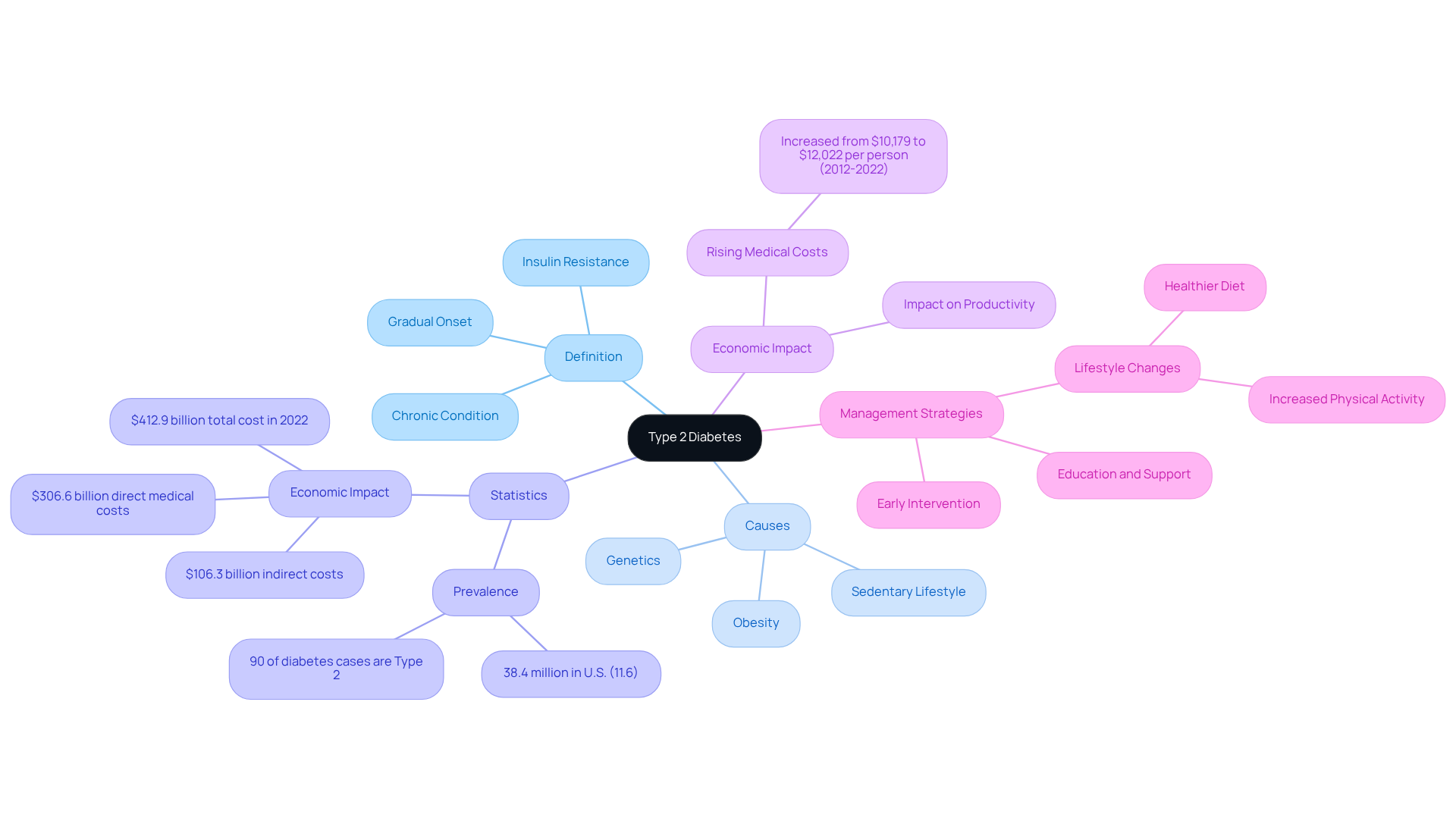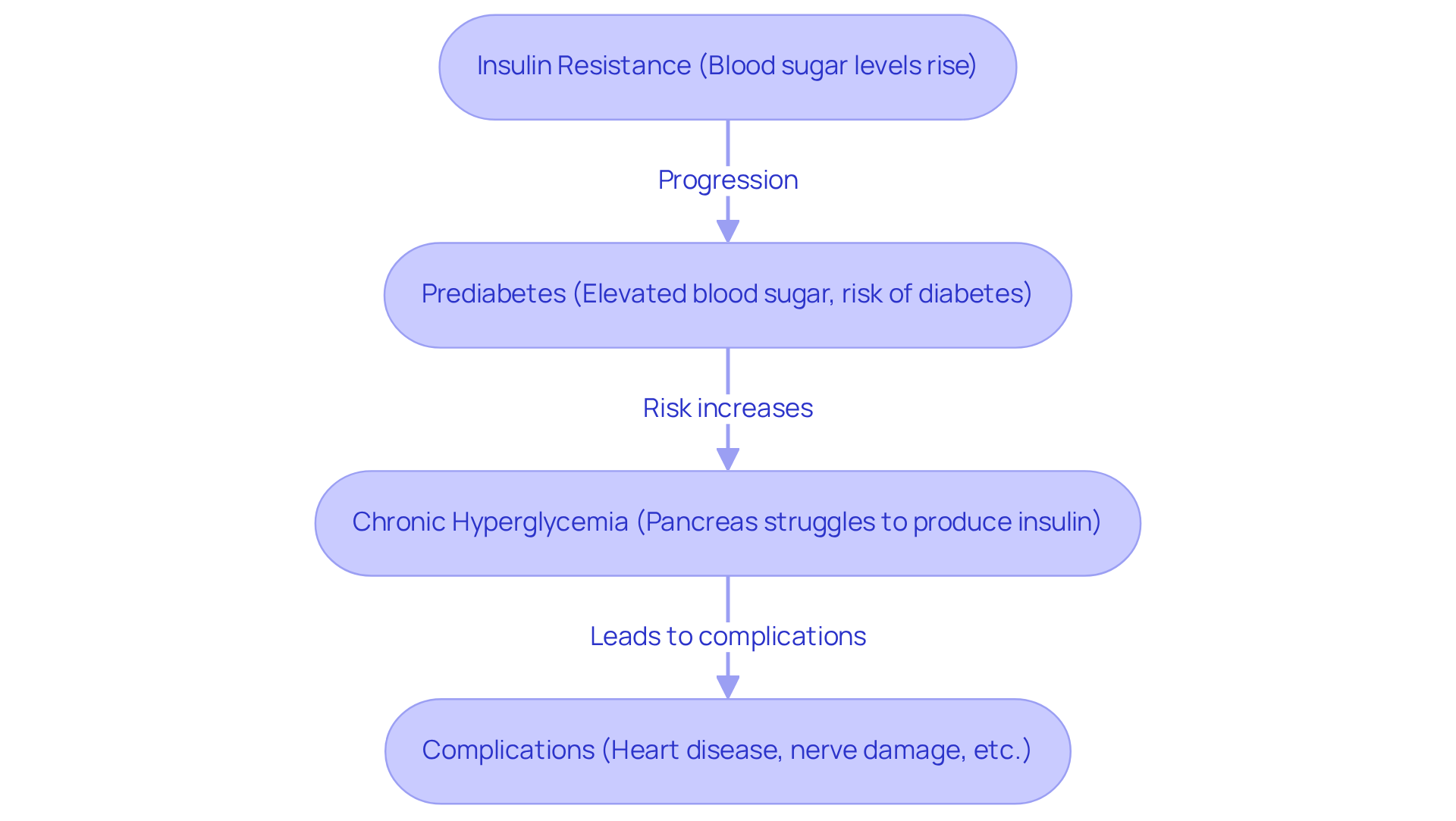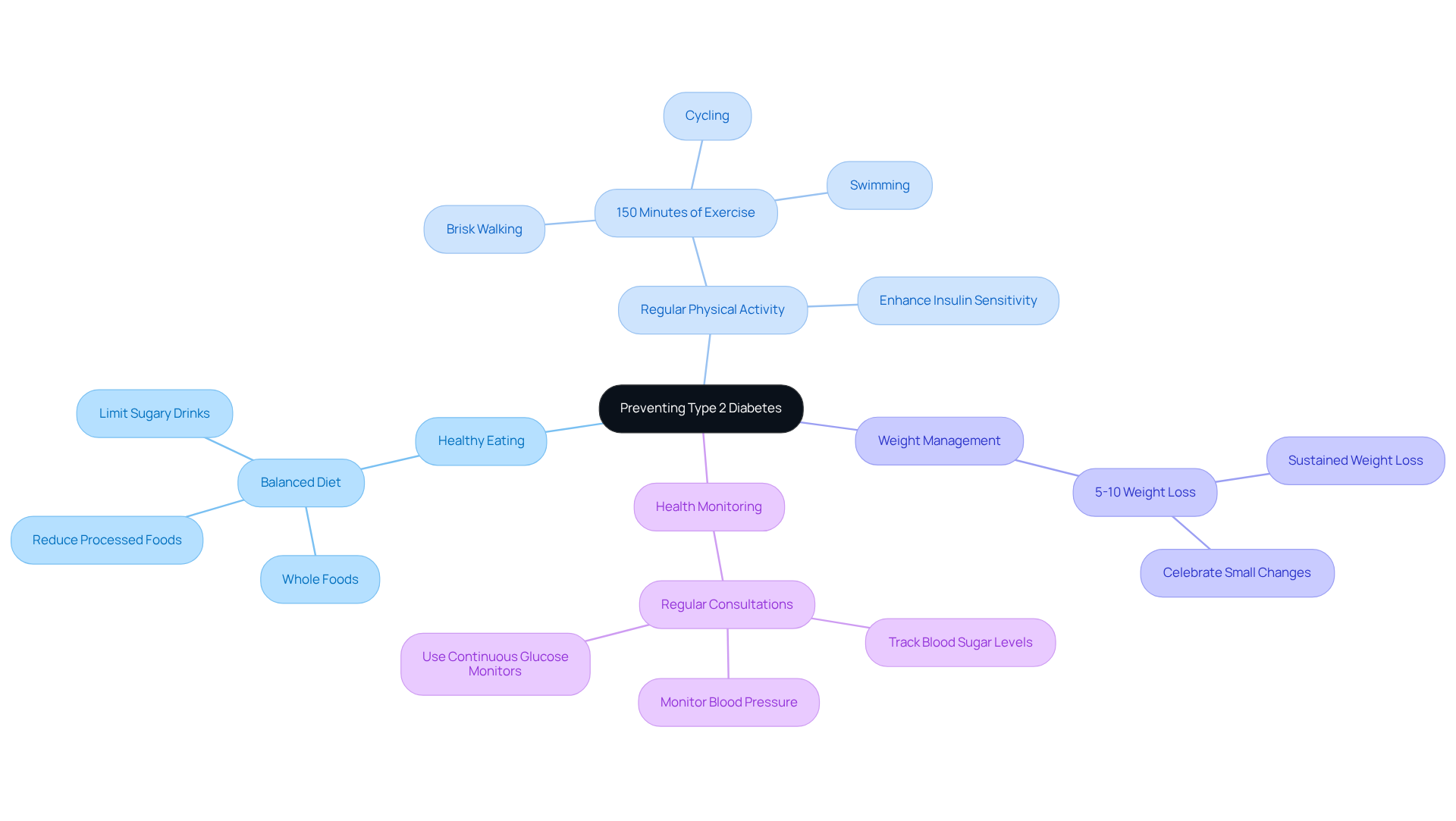Overview
Type 2 diabetes can feel overwhelming, often arising from a mix of genetic, lifestyle, and environmental factors that lead to insulin resistance and inadequate insulin production. It’s important to recognize that many individuals struggle with this condition, and factors like obesity, sedentary behavior, and poor dietary choices can significantly contribute to it. However, there is hope. Early intervention and lifestyle changes can make a real difference, helping to prevent the progression of diabetes and improve overall health outcomes.
Many patients find that small adjustments in their daily routines can lead to meaningful improvements. Have you considered how your lifestyle choices might affect your health? By acknowledging these challenges, we can begin to explore supportive strategies together. Remember, you are not alone on this journey.
Taking proactive steps towards a healthier lifestyle is not just about managing diabetes; it’s about enhancing your quality of life. Imagine feeling more energetic and confident in your choices. This is possible with the right guidance and support.
As you consider the 30-Day Diabetes Reset program, think about the positive changes you can make. Simple changes, such as:
- Incorporating more physical activity
- Making healthier food choices
can lead to significant improvements.
Remember, every small step counts. You have the power to make a difference in your health journey, and we’re here to support you every step of the way.
Introduction
Understanding the intricacies of type 2 diabetes is essential in a world where its prevalence continues to rise, affecting millions globally. This chronic condition arises from a complex interplay of genetic, lifestyle, and environmental factors. It’s important to recognize that managing type 2 diabetes involves not just addressing immediate health implications but also considering long-term consequences. As individuals navigate these challenges, many may wonder: what proactive steps can be taken to prevent the onset of type 2 diabetes and mitigate its progression?
Exploring the causes and stages of this condition reveals critical insights that can empower individuals to take control of their health. By making informed lifestyle choices, you can significantly influence your well-being. Remember, you are not alone on this journey; together, we can work towards a healthier future.
Understand Type 2 Diabetes: Definition and Overview
Type 2 diabetes is a chronic condition that can feel overwhelming, characterized by elevated blood sugar levels due to insulin resistance and insufficient insulin production. Unlike Type 1 diabetes, where the body cannot produce insulin, it is important to understand how does type 2 diabetes develop, as it often progresses gradually and can frequently go unnoticed for years. It’s important to recognize how does type 2 diabetes develop, highlighting that key factors such as obesity, sedentary lifestyles, and genetics play significant roles in its onset.
Many patients find that they are not alone in this struggle, as recent studies reveal that over 90% of individuals with diabetes are diagnosed with Type 2. This highlights its prevalence as a leading cause of illness and death worldwide. In the United States, about 38.4 million people, or 11.6% of the population, were identified with the condition in 2021, with Type 2 accounting for the majority of these cases.
The economic impact of Type 2 diabetes is staggering, with total costs soaring to $412.9 billion in 2022. This underscores the urgent need for effective management and prevention strategies. Real-world examples of successful management often involve lifestyle changes, such as adopting a healthier diet and increasing physical activity, leading to significant improvements in overall wellness.
Endocrinologists emphasize that early intervention and education are crucial in changing the course of this condition. By taking proactive steps, individuals can manage their health more effectively and reduce the risk of complications associated with diabetes. Remember, you are not alone on this journey, and support is available to help you take control of your health.
Explore the Causes of Type 2 Diabetes: Genetic, Lifestyle, and Environmental Factors
Understanding how does type 2 diabetes develop involves examining a complex interplay of genetic, lifestyle, and environmental factors. It’s important to recognize that these elements can often feel overwhelming, but understanding them can empower you to take control of your health.
-
Genetic Factors: A family history of diabetes significantly increases your risk. Certain genetic variants can predispose individuals to insulin resistance. Research shows that people with a high genetic vulnerability have a lifetime chance of developing type 2 diabetes that is 1.83 times higher than those with a low genetic vulnerability. Acknowledging this can help you understand why monitoring your health is so crucial.
-
Many patients discover that lifestyle choices are crucial in understanding how does type 2 diabetes develop. Poor dietary habits, characterized by high-calorie intake from processed foods, contribute to obesity and insulin resistance. Consistent physical activity is essential; studies indicate that weight reduction and enhanced exercise can lower the likelihood of developing diabetes-related conditions by as much as 58% in individuals with a high risk. Nutritionists stress that adopting a balanced diet abundant in whole foods can greatly reduce the likelihood of health issues related to diabetes. Have you considered how small changes in your daily routine could lead to significant improvements?
-
Environmental Factors: The environment also plays a critical role in the occurrence of this condition. Socioeconomic status can limit access to healthy food options, particularly in neighborhoods with few grocery stores, leading to unhealthy eating patterns. Additionally, exposure to environmental pollutants has been linked to increased diabetes risk. For instance, a couple who collectively shed 118 pounds through lifestyle modifications demonstrates the significant influence of environmental and personal decisions on well-being outcomes. Reflecting on your surroundings can help you identify areas for positive change.
Understanding how does type 2 diabetes develop is crucial for creating efficient prevention strategies and enabling individuals to take charge of their well-being. Remember, you are not alone in this journey, and there are resources available, such as the 30-Day Diabetes Reset program, to support you every step of the way.
Examine the Progression of Type 2 Diabetes: Stages and Implications for Health
Understanding how does type 2 diabetes develop involves recognizing the several critical stages, each with significant health implications that can feel overwhelming.
-
Insulin Resistance: In this initial stage, the body’s cells become less responsive to insulin, resulting in elevated blood sugar levels. This condition often serves as a precursor to more severe health issues, making it important to understand how does type 2 diabetes develop, as early intervention can make a difference.
-
Prediabetes: At this stage, blood sugar levels are elevated but not high enough for a diagnosis. Approximately 15-30% of individuals with prediabetes may develop type 2 diabetes within five years if no lifestyle changes are made. This stage is crucial for intervention, as effective management can prevent progression. Have you considered setting SMART goals—specific, measurable, attainable, relevant, and time-bound? For instance, aiming to reach 10,000 steps daily or extending your exercise duration by five minutes each week can be beneficial. Utilizing tracking methods such as fitness apps or journals can further enhance accountability and help you monitor your progress.
-
To understand how does type 2 diabetes develop, it’s important to note that the pancreas struggles to produce sufficient insulin to maintain normal blood sugar levels, leading to chronic hyperglycemia. This condition can cause serious damage to the body, particularly affecting nerves and blood vessels, and is linked to an increased risk of cardiovascular disease. Many patients find that consistently evaluating their progress and adjusting objectives in response to shifting fitness levels can promote accountability and improve overall wellness management.
-
Complications: If left unmanaged, type 2 diabetes can lead to severe health complications, including cardiovascular disease, nerve damage, kidney failure, and vision problems. In fact, this condition is the leading cause of new instances of blindness among adults aged 18-64 years. The economic impact is also substantial, with the total projected expense of diagnosed conditions in the U.S. hitting $327 billion in 2017. Identifying these phases can encourage individuals to learn how does type 2 diabetes develop, prompting them to pursue early intervention and adopt lifestyle modifications, ultimately enhancing their quality of life and lowering the risk of serious medical outcomes. Participating in community wellness initiatives and using local resources can significantly enhance effective management of the condition. Remember, you are not alone on this journey, and there are many resources available to support you.
Implement Prevention Strategies: Lifestyle Changes and Health Monitoring
Preventing type 2 diabetes can feel overwhelming, but it’s important to recognize that a multifaceted approach can make a significant difference. By combining lifestyle modifications with consistent health monitoring, you can take meaningful steps toward better health.
-
Healthy Eating: Embrace a balanced diet that emphasizes whole foods, such as fruits, vegetables, whole grains, and lean proteins. Many find that reducing processed foods and sugary drinks is crucial for maintaining stable blood sugar levels. It’s a journey, and every small change counts.
-
Regular Physical Activity: Engaging in at least 150 minutes of moderate-intensity exercise weekly can be a game changer. Activities like brisk walking, cycling, and swimming not only enhance insulin sensitivity but also contribute to overall metabolic health. Fitness specialists highlight that consistent physical exercise can lower the chance of developing type 2 blood sugar issues by about 50%. Imagine how good it feels to move your body and improve your health!
-
Weight Management: Attaining even a slight weight reduction of 5-10% can greatly decrease the likelihood of developing health issues related to blood sugar. Research shows that individuals who sustain this weight loss over time experience a significant decrease in the occurrence of diabetes-related conditions. Every step toward your goal is a victory worth celebrating.
-
Health Monitoring: Regular consultations with healthcare providers are essential for tracking blood sugar levels, blood pressure, and cholesterol. Utilizing tools such as continuous glucose monitors can offer real-time insights into blood sugar fluctuations, enabling proactive management of potential issues. For example, lifestyle changes have demonstrated a 69% decrease in the likelihood of developing health issues among individuals who lost 5% of their body weight during a one-year program. Remember, you’re not alone in this journey.
By integrating these strategies, you can effectively reduce your risk of developing type 2 diabetes and learn how does type 2 diabetes develop to improve your overall health. It’s about taking one step at a time and being kind to yourself along the way.
Conclusion
Understanding the development of Type 2 diabetes is essential for effective management and prevention. This chronic condition arises from a combination of genetic predisposition, lifestyle choices, and environmental influences, leading to insulin resistance and elevated blood sugar levels over time. It’s important to recognize that acknowledging the gradual progression of Type 2 diabetes can empower individuals to take proactive steps toward their health, emphasizing that early intervention is crucial in altering its course.
Many patients find that key factors contributing to the onset and progression of Type 2 diabetes include:
- Genetic influences
- Poor dietary habits
- Lack of physical activity
The stages of development—from insulin resistance to prediabetes and potential complications—highlight the importance of lifestyle modifications and health monitoring. Engaging in a balanced diet, regular exercise, and weight management can effectively reduce the risk of developing severe health issues associated with diabetes.
Ultimately, the journey to prevent Type 2 diabetes involves a commitment to understanding personal health and making informed choices. Adopting healthier habits not only enhances well-being but also fosters a supportive community that encourages accountability and shared goals. By taking these steps, individuals can significantly improve their quality of life and mitigate the risks associated with this prevalent condition.
Frequently Asked Questions
What is Type 2 diabetes?
Type 2 diabetes is a chronic condition characterized by elevated blood sugar levels due to insulin resistance and insufficient insulin production.
How does Type 2 diabetes develop?
Type 2 diabetes often develops gradually and can go unnoticed for years. Key factors contributing to its onset include obesity, sedentary lifestyles, and genetics.
How prevalent is Type 2 diabetes?
Over 90% of individuals diagnosed with diabetes have Type 2 diabetes. In the United States, approximately 38.4 million people, or 11.6% of the population, were identified with Type 2 diabetes in 2021.
What is the economic impact of Type 2 diabetes?
The total costs associated with Type 2 diabetes reached $412.9 billion in 2022, highlighting the urgent need for effective management and prevention strategies.
What are some successful management strategies for Type 2 diabetes?
Successful management often involves lifestyle changes such as adopting a healthier diet and increasing physical activity, which can lead to significant improvements in overall wellness.
Why is early intervention important for Type 2 diabetes?
Early intervention and education are crucial in changing the course of Type 2 diabetes, allowing individuals to manage their health more effectively and reduce the risk of complications.
Is support available for those with Type 2 diabetes?
Yes, individuals with Type 2 diabetes can access support to help them take control of their health and navigate their journey with the condition.



